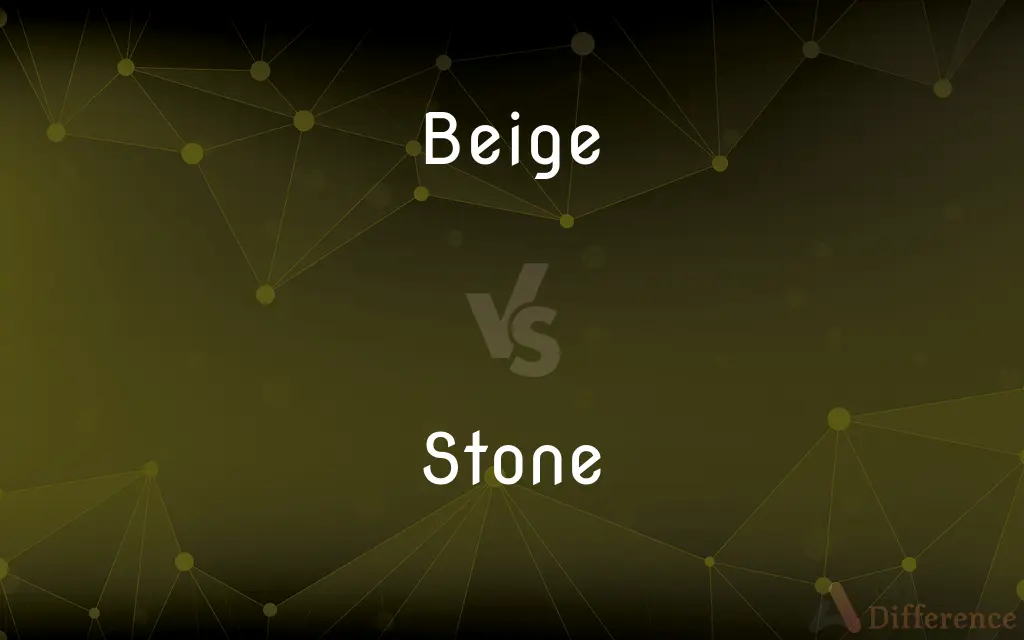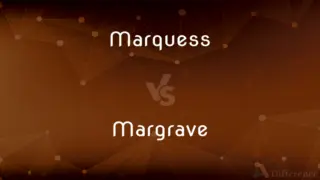Beige vs. Stone — What's the Difference?
By Urooj Arif & Fiza Rafique — Updated on April 7, 2024
Beige is a light, warm, neutral color often associated with simplicity and subtlety, while stone refers to a range of gray or neutral tones inspired by natural rocks.

Difference Between Beige and Stone
Table of Contents
ADVERTISEMENT
Key Differences
Beige is known for its versatility in fashion and interior design, offering a warm, neutral backdrop that complements a wide range of colors. It's often used to create a serene and inviting atmosphere. Stone, on the other hand, carries a cooler, more natural connotation, often used in design to bring an earthy, robust feel to spaces.
The color beige evokes a sense of simplicity and calm, making it a popular choice for minimalist aesthetics. It's associated with the natural color of wool or unbleached linen. Stone colors, whereas, are inspired by the varied hues of natural rocks, ranging from light grays to deeper slate tones, adding a grounded, stable element to design.
Beige is often preferred for its ability to brighten spaces and make them appear larger and more open. It works well in spaces aiming for a soft, neutral look without the starkness of white. Stone colors, conversely, provide a sense of solidity and timelessness, often used in materials like countertops, flooring, and walls for both interior and exterior applications.
In fashion, beige offers a classic, understated elegance, easily pairing with bolder colors for a balanced look. It's a staple in wardrobes for its versatility and timeless appeal. Stone colors in fashion are appreciated for their natural, subdued quality, offering a strong foundation for building a neutral wardrobe that still carries visual interest and depth.
While beige is celebrated for its warmth and lightness, adding a cozy dimension to designs, stone brings an element of nature and a more pronounced sense of durability and strength. Both colors have their unique places in design and fashion, each bringing a different mood and style to the table.
ADVERTISEMENT
Comparison Chart
Color Tone
Light, warm, and neutral.
Varies from light to dark gray, neutral.
Associated Feelings
Calm, simplicity, warmth.
Earthiness, robustness, stability.
Use in Design
Brightens spaces, versatile.
Adds solidity, natural feel.
Use in Fashion
Timeless elegance, pairs well with bold colors.
Natural, subdued, versatile foundation.
Symbolism
Minimalism, unobtrusiveness.
Durability, timelessness.
Compare with Definitions
Beige
Often used to create serene and inviting atmospheres.
The beige palette in the café created a cozy, welcoming environment.
Stone
Used to bring a natural, grounded feel to spaces.
The kitchen's stone countertops were both beautiful and durable.
Beige
A light, warm, neutral color.
The beige walls gave the room a warm, inviting feel.
Stone
Associated with durability and timelessness in design.
They chose a stone pathway for its durability and natural look.
Beige
A color that complements a wide range of colors.
The beige dress was a perfect base for her colorful accessories.
Stone
Conveys a sense of earthiness and robustness.
The stone facade of the building gave it a robust and timeless appearance.
Beige
Associated with simplicity and subtlety.
She preferred beige tones for their simplicity and versatility.
Stone
Offers a strong foundation for neutral wardrobes.
His stone-colored coat was versatile enough for any outfit.
Beige
Popular in minimalist design.
Their home's beige interior underscored a minimalist aesthetic.
Stone
A range of gray or neutral tones inspired by natural rocks.
The stone-colored tiles added an earthy feel to the bathroom.
Beige
Beige is variously described as a pale sandy fawn color, a grayish tan, a light-grayish yellowish brown, or a pale to grayish yellow. It takes its name from French, where the word originally meant natural wool that has been neither bleached nor dyed, hence also the color of natural wool.
Stone
Hard solid non-metallic mineral matter of which rock is made, especially as a building material
The houses are built of stone
High stone walls
Beige
A pale sandy fawn colour
A beige raincoat
Tones of beige and green
Stone
A piece of stone shaped for a purpose, especially one of commemoration, ceremony, or demarcation
A memorial stone
Boundary stones
Beige
A light grayish brown or yellowish brown to grayish yellow.
Stone
A hard seed in a cherry, plum, peach, and some other fruits.
Beige
A soft fabric of undyed, unbleached wool.
Stone
A unit of weight equal to 14 lb (6.35 kg)
I weighed 10 stone
Beige
Light grayish-brown or yellowish-brown to grayish-yellow.
Stone
A natural shade of whitish or brownish-grey
Stone stretch trousers
Beige
A slightly yellowish gray colour, as that of unbleached wool.
Stone
Throw stones at
Two people were stoned to death
Policemen were stoned by the crowd
Beige
Debeige; a kind of woollen or mixed dress goods.
Stone
Remove the stone from (a fruit).
Beige
Having a slightly yellowish gray colour, as that of unbleached wool.
Stone
Build, face, or pave with stone
The honey-stoned, eighteenth-century city
Beige
Comfortably dull and unadventurous, in a way that suggests middle-class suburbia.
Stone
Concreted earthy or mineral matter; rock.
Beige
Debeige.
Stone
Such concreted matter of a particular type. Often used in combination
Sandstone.
Soapstone.
Beige
A very light brown
Stone
A small piece of rock.
Beige
Of a light grayish-brown color
Stone
A piece of rock that is used in construction
A coping stone.
A paving stone.
Stone
A gravestone or tombstone.
Stone
A grindstone, millstone, or whetstone.
Stone
A milestone or boundary.
Stone
A gem or precious stone.
Stone
Something, such as a hailstone, resembling a stone in shape or hardness.
Stone
(Botany) The hard covering enclosing the seed in certain fruits, such as the cherry, plum, or peach.
Stone
(Medicine) A mineral concretion in an organ, such as the kidney or gallbladder, or other body part; a calculus.
Stone
Pl. stone Abbr. st. A unit of weight in Great Britain, 14 pounds (6.4 kilograms).
Stone
(Printing) A table with a smooth surface on which page forms are composed.
Stone
Relating to or made of stone
A stone wall.
Stone
Made of stoneware or earthenware.
Stone
Complete; utter. Often used in combination
A stone liar.
Stone-deaf.
Stone
Completely; utterly
Stone cold.
Standing stone still.
Stone
To remove the stones or pits from.
Stone
To furnish, fit, pave, or line with stones.
Stone
To rub on or with a stone in order to polish or sharpen.
Stone
(Sports) To block a shot taken by (an opponent). Used of a goalie.
Stone
(Obsolete) To make hard or indifferent.
Stone
(uncountable) A hard earthen substance that can form large rocks.
Stone
A small piece of stone, a pebble.
Stone
A gemstone, a jewel, especially a diamond.
Stone
(British) A unit of mass equal to 14 pounds (≈6.3503 kilograms), formerly used for various commodities (wool, cheese, etc.), but now principally used for personal weight.
Stone
(botany) The central part of some fruits, particularly drupes; consisting of the seed and a hard endocarp layer.
A peach stone
Stone
(medicine) A hard, stone-like deposit.
Stone
(board games) A playing piece made of any hard material, used in various board games such as backgammon and go.
Stone
A dull light grey or beige, like that of some stones.
Stone
(curling) A 42-pound, precisely shaped piece of granite with a handle attached, which is bowled down the ice.
Stone
(obsolete) A mirror, or its glass.
Stone
(obsolete) A testicle.
Stone
A stand or table with a smooth, flat top of stone, commonly marble, on which to arrange the pages of a book, newspaper, etc. before printing.
Stone
(transitive) To wall with stones.
Stone
(transitive) To remove a stone from (fruit etc.).
Stone
(intransitive) To form a stone during growth, with reference to fruit etc.
Stone
To intoxicate, especially with narcotics. Usually in passive
Stone
To do nothing, to stare blankly into space and not pay attention when relaxing or when bored.
Stone
(transitive) To lap with an abrasive stone to remove surface irregularities.
Stone
Constructed of stone.
Stone walls
Stone
Having the appearance of stone.
Stone pot
Stone
Of a dull light grey or beige, like that of some stones.
Stone
(AAVE) Used as an intensifier.
She is one stone fox.
Stone
As a stone used with following adjective.
My father is stone deaf. This soup is stone cold.
Stone
(slang) Absolutely, completely used with following adjectives.
I went stone crazy after she left.
I said the medication made my vision temporarily blurry, it did not make me stone blind.
Stone
Concreted earthy or mineral matter; also, any particular mass of such matter; as, a house built of stone; the boy threw a stone; pebbles are rounded stones.
They had brick for stone, and slime . . . for mortar.
Stone
A precious stone; a gem.
Stone
Something made of stone. Specifically: -
Stone
The glass of a mirror; a mirror.
Lend me a looking-glass;If that her breath will mist or stain the stone,Why, then she lives.
Stone
A calculous concretion, especially one in the kidneys or bladder; the disease arising from a calculus.
Stone
One of the testes; a testicle.
Stone
The hard endocarp of drupes; as, the stone of a cherry or peach. See Illust. of Endocarp.
Stone
A weight which legally is fourteen pounds, but in practice varies with the article weighed.
Stone
Fig.: Symbol of hardness and insensibility; torpidness; insensibility; as, a heart of stone.
I have not yet forgot myself to stone.
Stone
A stand or table with a smooth, flat top of stone, commonly marble, on which to arrange the pages of a book, newspaper, etc., before printing; - called also imposing stone.
Stone
To make like stone; to harden.
O perjured woman! thou dost stone my heart.
Stone
To free from stones; also, to remove the seeds of; as, to stone a field; to stone cherries; to stone raisins.
Stone
To wall or face with stones; to line or fortify with stones; as, to stone a well; to stone a cellar.
Stone
To rub, scour, or sharpen with a stone.
Stone
A lump or mass of hard consolidated mineral matter;
He threw a rock at me
Stone
Material consisting of the aggregate of minerals like those making up the Earth's crust;
That mountain is solid rock
Stone is abundant in New England and there are many quarries
Stone
Building material consisting of a piece of rock hewn in a definite shape for a special purpose;
He wanted a special stone to mark the site
Stone
A crystalline rock that can be cut and polished for jewelry;
He had the gem set in a ring for his wife
She had jewels made of all the rarest stones
Stone
The hard inner (usually woody) layer of the pericarp of some fruits (as peaches or plums or cherries or olives) that contains the seed;
You should remove the stones from prunes before cooking
Stone
An avoirdupois unit used to measure the weight of a human body; equal to 14 pounds;
A heavy chap who must have weighed more than twenty stone
Stone
United States filmmaker (born in 1946)
Stone
United States feminist and suffragist (1818-1893)
Stone
United States journalist who advocated liberal causes (1907-1989)
Stone
United States jurist who served on the United States Supreme Court as Chief Justice (1872-1946)
Stone
United States architect (1902-1978)
Stone
A lack of feeling or expression or movement;
He must have a heart of stone
Her face was as hard as stone
Stone
Remove the pits from;
Pit plums and cherries
Stone
Of any of various dull tannish-gray colors
Common Curiosities
Which color is more versatile for fashion, beige or stone?
Both are versatile; beige offers a classic elegance, while stone provides a natural, subdued foundation that pairs well with various colors.
How does stone differ from beige in design?
Stone refers to a range of gray or neutral tones inspired by natural rocks, often used to convey a sense of earthiness and stability, in contrast to the warm and inviting feel of beige.
What is beige?
Beige is a light, warm, neutral color, often associated with simplicity and versatility in design and fashion.
Is beige suitable for all types of interior design?
Beige is incredibly versatile and suitable for many design styles, particularly where a light, warm, and inviting atmosphere is desired.
Which color is preferred for minimalist aesthetics?
Beige is often preferred for its ability to underscore minimalism with its simplicity and warmth.
What feelings do stone colors evoke?
Stone colors evoke feelings of stability, durability, and a connection to nature.
Which color is better for exterior design?
Stone colors are often preferred for exteriors due to their durability and natural look.
How can one incorporate beige and stone colors into a wardrobe?
By using them as foundational colors that can be easily paired with bolder colors for a balanced and versatile wardrobe.
What type of materials commonly come in stone colors?
Natural materials like granite, marble, and slate commonly feature stone colors.
Can beige and stone colors be used together in design?
Yes, beige and stone colors can complement each other well, combining warmth and natural elements in a space.
How do beige and stone colors influence the perception of space?
Beige can make spaces appear larger and brighter, while stone colors add depth and a grounded feel.
Are there different shades of beige and stone?
Yes, both beige and stone come in a variety of shades, from lighter to darker tones, allowing for great flexibility in design.
Can beige be used in modern design?
Absolutely, beige can add warmth and neutrality in modern design, balancing out cooler modern elements.
Share Your Discovery

Previous Comparison
Marquess vs. Margrave
Next Comparison
Earmark vs. BookmarkAuthor Spotlight
Written by
Urooj ArifUrooj is a skilled content writer at Ask Difference, known for her exceptional ability to simplify complex topics into engaging and informative content. With a passion for research and a flair for clear, concise writing, she consistently delivers articles that resonate with our diverse audience.
Co-written by
Fiza RafiqueFiza Rafique is a skilled content writer at AskDifference.com, where she meticulously refines and enhances written pieces. Drawing from her vast editorial expertise, Fiza ensures clarity, accuracy, and precision in every article. Passionate about language, she continually seeks to elevate the quality of content for readers worldwide.














































